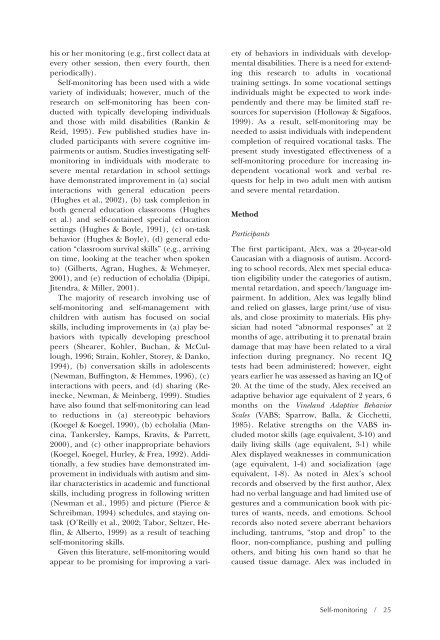Education and Training in Developmental Disabilities - Division on ...
Education and Training in Developmental Disabilities - Division on ...
Education and Training in Developmental Disabilities - Division on ...
You also want an ePaper? Increase the reach of your titles
YUMPU automatically turns print PDFs into web optimized ePapers that Google loves.
his or her m<strong>on</strong>itor<str<strong>on</strong>g>in</str<strong>on</strong>g>g (e.g., first collect data at<br />
every other sessi<strong>on</strong>, then every fourth, then<br />
periodically).<br />
Self-m<strong>on</strong>itor<str<strong>on</strong>g>in</str<strong>on</strong>g>g has been used with a wide<br />
variety of <str<strong>on</strong>g>in</str<strong>on</strong>g>dividuals; however, much of the<br />
research <strong>on</strong> self-m<strong>on</strong>itor<str<strong>on</strong>g>in</str<strong>on</strong>g>g has been c<strong>on</strong>ducted<br />
with typically develop<str<strong>on</strong>g>in</str<strong>on</strong>g>g <str<strong>on</strong>g>in</str<strong>on</strong>g>dividuals<br />
<str<strong>on</strong>g>and</str<strong>on</strong>g> those with mild disabilities (Rank<str<strong>on</strong>g>in</str<strong>on</strong>g> &<br />
Reid, 1995). Few published studies have <str<strong>on</strong>g>in</str<strong>on</strong>g>cluded<br />
participants with severe cognitive impairments<br />
or autism. Studies <str<strong>on</strong>g>in</str<strong>on</strong>g>vestigat<str<strong>on</strong>g>in</str<strong>on</strong>g>g selfm<strong>on</strong>itor<str<strong>on</strong>g>in</str<strong>on</strong>g>g<br />
<str<strong>on</strong>g>in</str<strong>on</strong>g> <str<strong>on</strong>g>in</str<strong>on</strong>g>dividuals with moderate to<br />
severe mental retardati<strong>on</strong> <str<strong>on</strong>g>in</str<strong>on</strong>g> school sett<str<strong>on</strong>g>in</str<strong>on</strong>g>gs<br />
have dem<strong>on</strong>strated improvement <str<strong>on</strong>g>in</str<strong>on</strong>g> (a) social<br />
<str<strong>on</strong>g>in</str<strong>on</strong>g>teracti<strong>on</strong>s with general educati<strong>on</strong> peers<br />
(Hughes et al., 2002), (b) task completi<strong>on</strong> <str<strong>on</strong>g>in</str<strong>on</strong>g><br />
both general educati<strong>on</strong> classrooms (Hughes<br />
et al.) <str<strong>on</strong>g>and</str<strong>on</strong>g> self-c<strong>on</strong>ta<str<strong>on</strong>g>in</str<strong>on</strong>g>ed special educati<strong>on</strong><br />
sett<str<strong>on</strong>g>in</str<strong>on</strong>g>gs (Hughes & Boyle, 1991), (c) <strong>on</strong>-task<br />
behavior (Hughes & Boyle), (d) general educati<strong>on</strong><br />
“classroom survival skills” (e.g., arriv<str<strong>on</strong>g>in</str<strong>on</strong>g>g<br />
<strong>on</strong> time, look<str<strong>on</strong>g>in</str<strong>on</strong>g>g at the teacher when spoken<br />
to) (Gilberts, Agran, Hughes, & Wehmeyer,<br />
2001), <str<strong>on</strong>g>and</str<strong>on</strong>g> (e) reducti<strong>on</strong> of echolalia (Dipipi,<br />
Jitendra, & Miller, 2001).<br />
The majority of research <str<strong>on</strong>g>in</str<strong>on</strong>g>volv<str<strong>on</strong>g>in</str<strong>on</strong>g>g use of<br />
self-m<strong>on</strong>itor<str<strong>on</strong>g>in</str<strong>on</strong>g>g <str<strong>on</strong>g>and</str<strong>on</strong>g> self-management with<br />
children with autism has focused <strong>on</strong> social<br />
skills, <str<strong>on</strong>g>in</str<strong>on</strong>g>clud<str<strong>on</strong>g>in</str<strong>on</strong>g>g improvements <str<strong>on</strong>g>in</str<strong>on</strong>g> (a) play behaviors<br />
with typically develop<str<strong>on</strong>g>in</str<strong>on</strong>g>g preschool<br />
peers (Shearer, Kohler, Buchan, & McCullough,<br />
1996; Stra<str<strong>on</strong>g>in</str<strong>on</strong>g>, Kohler, Storey, & Danko,<br />
1994), (b) c<strong>on</strong>versati<strong>on</strong> skills <str<strong>on</strong>g>in</str<strong>on</strong>g> adolescents<br />
(Newman, Buff<str<strong>on</strong>g>in</str<strong>on</strong>g>gt<strong>on</strong>, & Hemmes, 1996), (c)<br />
<str<strong>on</strong>g>in</str<strong>on</strong>g>teracti<strong>on</strong>s with peers, <str<strong>on</strong>g>and</str<strong>on</strong>g> (d) shar<str<strong>on</strong>g>in</str<strong>on</strong>g>g (Re<str<strong>on</strong>g>in</str<strong>on</strong>g>ecke,<br />
Newman, & Me<str<strong>on</strong>g>in</str<strong>on</strong>g>berg, 1999). Studies<br />
have also found that self-m<strong>on</strong>itor<str<strong>on</strong>g>in</str<strong>on</strong>g>g can lead<br />
to reducti<strong>on</strong>s <str<strong>on</strong>g>in</str<strong>on</strong>g> (a) stereotypic behaviors<br />
(Koegel & Koegel, 1990), (b) echolalia (Manc<str<strong>on</strong>g>in</str<strong>on</strong>g>a,<br />
Tankersley, Kamps, Kravits, & Parrett,<br />
2000), <str<strong>on</strong>g>and</str<strong>on</strong>g> (c) other <str<strong>on</strong>g>in</str<strong>on</strong>g>appropriate behaviors<br />
(Koegel, Koegel, Hurley, & Frea, 1992). Additi<strong>on</strong>ally,<br />
a few studies have dem<strong>on</strong>strated improvement<br />
<str<strong>on</strong>g>in</str<strong>on</strong>g> <str<strong>on</strong>g>in</str<strong>on</strong>g>dividuals with autism <str<strong>on</strong>g>and</str<strong>on</strong>g> similar<br />
characteristics <str<strong>on</strong>g>in</str<strong>on</strong>g> academic <str<strong>on</strong>g>and</str<strong>on</strong>g> functi<strong>on</strong>al<br />
skills, <str<strong>on</strong>g>in</str<strong>on</strong>g>clud<str<strong>on</strong>g>in</str<strong>on</strong>g>g progress <str<strong>on</strong>g>in</str<strong>on</strong>g> follow<str<strong>on</strong>g>in</str<strong>on</strong>g>g written<br />
(Newman et al., 1995) <str<strong>on</strong>g>and</str<strong>on</strong>g> picture (Pierce &<br />
Schreibman, 1994) schedules, <str<strong>on</strong>g>and</str<strong>on</strong>g> stay<str<strong>on</strong>g>in</str<strong>on</strong>g>g <strong>on</strong>task<br />
(O’Reilly et al., 2002; Tabor, Seltzer, Hefl<str<strong>on</strong>g>in</str<strong>on</strong>g>,<br />
& Alberto, 1999) as a result of teach<str<strong>on</strong>g>in</str<strong>on</strong>g>g<br />
self-m<strong>on</strong>itor<str<strong>on</strong>g>in</str<strong>on</strong>g>g skills.<br />
Given this literature, self-m<strong>on</strong>itor<str<strong>on</strong>g>in</str<strong>on</strong>g>g would<br />
appear to be promis<str<strong>on</strong>g>in</str<strong>on</strong>g>g for improv<str<strong>on</strong>g>in</str<strong>on</strong>g>g a vari-<br />
ety of behaviors <str<strong>on</strong>g>in</str<strong>on</strong>g> <str<strong>on</strong>g>in</str<strong>on</strong>g>dividuals with developmental<br />
disabilities. There is a need for extend<str<strong>on</strong>g>in</str<strong>on</strong>g>g<br />
this research to adults <str<strong>on</strong>g>in</str<strong>on</strong>g> vocati<strong>on</strong>al<br />
tra<str<strong>on</strong>g>in</str<strong>on</strong>g><str<strong>on</strong>g>in</str<strong>on</strong>g>g sett<str<strong>on</strong>g>in</str<strong>on</strong>g>gs. In some vocati<strong>on</strong>al sett<str<strong>on</strong>g>in</str<strong>on</strong>g>gs<br />
<str<strong>on</strong>g>in</str<strong>on</strong>g>dividuals might be expected to work <str<strong>on</strong>g>in</str<strong>on</strong>g>dependently<br />
<str<strong>on</strong>g>and</str<strong>on</strong>g> there may be limited staff resources<br />
for supervisi<strong>on</strong> (Holloway & Sigafoos,<br />
1999). As a result, self-m<strong>on</strong>itor<str<strong>on</strong>g>in</str<strong>on</strong>g>g may be<br />
needed to assist <str<strong>on</strong>g>in</str<strong>on</strong>g>dividuals with <str<strong>on</strong>g>in</str<strong>on</strong>g>dependent<br />
completi<strong>on</strong> of required vocati<strong>on</strong>al tasks. The<br />
present study <str<strong>on</strong>g>in</str<strong>on</strong>g>vestigated effectiveness of a<br />
self-m<strong>on</strong>itor<str<strong>on</strong>g>in</str<strong>on</strong>g>g procedure for <str<strong>on</strong>g>in</str<strong>on</strong>g>creas<str<strong>on</strong>g>in</str<strong>on</strong>g>g <str<strong>on</strong>g>in</str<strong>on</strong>g>dependent<br />
vocati<strong>on</strong>al work <str<strong>on</strong>g>and</str<strong>on</strong>g> verbal requests<br />
for help <str<strong>on</strong>g>in</str<strong>on</strong>g> two adult men with autism<br />
<str<strong>on</strong>g>and</str<strong>on</strong>g> severe mental retardati<strong>on</strong>.<br />
Method<br />
Participants<br />
The first participant, Alex, was a 20-year-old<br />
Caucasian with a diagnosis of autism. Accord<str<strong>on</strong>g>in</str<strong>on</strong>g>g<br />
to school records, Alex met special educati<strong>on</strong><br />
eligibility under the categories of autism,<br />
mental retardati<strong>on</strong>, <str<strong>on</strong>g>and</str<strong>on</strong>g> speech/language impairment.<br />
In additi<strong>on</strong>, Alex was legally bl<str<strong>on</strong>g>in</str<strong>on</strong>g>d<br />
<str<strong>on</strong>g>and</str<strong>on</strong>g> relied <strong>on</strong> glasses, large pr<str<strong>on</strong>g>in</str<strong>on</strong>g>t/use of visuals,<br />
<str<strong>on</strong>g>and</str<strong>on</strong>g> close proximity to materials. His physician<br />
had noted “abnormal resp<strong>on</strong>ses” at 2<br />
m<strong>on</strong>ths of age, attribut<str<strong>on</strong>g>in</str<strong>on</strong>g>g it to prenatal bra<str<strong>on</strong>g>in</str<strong>on</strong>g><br />
damage that may have been related to a viral<br />
<str<strong>on</strong>g>in</str<strong>on</strong>g>fecti<strong>on</strong> dur<str<strong>on</strong>g>in</str<strong>on</strong>g>g pregnancy. No recent IQ<br />
tests had been adm<str<strong>on</strong>g>in</str<strong>on</strong>g>istered; however, eight<br />
years earlier he was assessed as hav<str<strong>on</strong>g>in</str<strong>on</strong>g>g an IQ of<br />
20. At the time of the study, Alex received an<br />
adaptive behavior age equivalent of 2 years, 6<br />
m<strong>on</strong>ths <strong>on</strong> the V<str<strong>on</strong>g>in</str<strong>on</strong>g>el<str<strong>on</strong>g>and</str<strong>on</strong>g> Adaptive Behavior<br />
Scales (VABS; Sparrow, Balla, & Cicchetti,<br />
1985). Relative strengths <strong>on</strong> the VABS <str<strong>on</strong>g>in</str<strong>on</strong>g>cluded<br />
motor skills (age equivalent, 3-10) <str<strong>on</strong>g>and</str<strong>on</strong>g><br />
daily liv<str<strong>on</strong>g>in</str<strong>on</strong>g>g skills (age equivalent, 3-1) while<br />
Alex displayed weaknesses <str<strong>on</strong>g>in</str<strong>on</strong>g> communicati<strong>on</strong><br />
(age equivalent, 1-4) <str<strong>on</strong>g>and</str<strong>on</strong>g> socializati<strong>on</strong> (age<br />
equivalent, 1-8). As noted <str<strong>on</strong>g>in</str<strong>on</strong>g> Alex’s school<br />
records <str<strong>on</strong>g>and</str<strong>on</strong>g> observed by the first author, Alex<br />
had no verbal language <str<strong>on</strong>g>and</str<strong>on</strong>g> had limited use of<br />
gestures <str<strong>on</strong>g>and</str<strong>on</strong>g> a communicati<strong>on</strong> book with pictures<br />
of wants, needs, <str<strong>on</strong>g>and</str<strong>on</strong>g> emoti<strong>on</strong>s. School<br />
records also noted severe aberrant behaviors<br />
<str<strong>on</strong>g>in</str<strong>on</strong>g>clud<str<strong>on</strong>g>in</str<strong>on</strong>g>g, tantrums, “stop <str<strong>on</strong>g>and</str<strong>on</strong>g> drop” to the<br />
floor, n<strong>on</strong>-compliance, push<str<strong>on</strong>g>in</str<strong>on</strong>g>g <str<strong>on</strong>g>and</str<strong>on</strong>g> pull<str<strong>on</strong>g>in</str<strong>on</strong>g>g<br />
others, <str<strong>on</strong>g>and</str<strong>on</strong>g> bit<str<strong>on</strong>g>in</str<strong>on</strong>g>g his own h<str<strong>on</strong>g>and</str<strong>on</strong>g> so that he<br />
caused tissue damage. Alex was <str<strong>on</strong>g>in</str<strong>on</strong>g>cluded <str<strong>on</strong>g>in</str<strong>on</strong>g><br />
Self-m<strong>on</strong>itor<str<strong>on</strong>g>in</str<strong>on</strong>g>g / 25
















